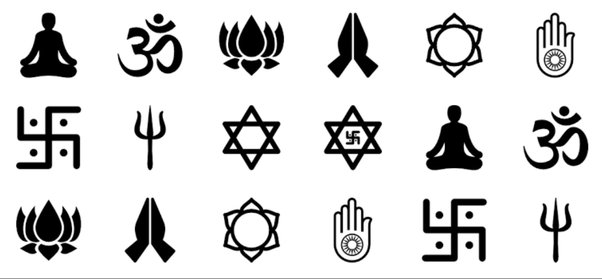Hindu Beliefs and Practices
Image courtesy: Quora
(Not imposing my worldview on others is Hinduism. Not accepting others imposing their worldview on me is Hindutva).
Following a request from Xavier College to the President of the Hindu Temple and Cultural Centre, Canberra, I was asked to deliver a one-hour talk on Hindu beliefs and practices to 240 students split into two groups — morning and afternoon — on 03 April 2024. The students were in grades 10 and 11.
I divided the talk into five themes:
- Who is a Hindu and what is Hinduism?
- What are beliefs and how are these formed?
- What are core Hindu beliefs?
- What are practices and how do they arise?
- What are core Hindu practices?
1. Who is a Hindu?
It is difficult to define who a Hindu is. It is because people follow diverse practices which range from worshiping at home or the temple their chosen deity or not worshipping at all. Hindu tradition provides freedom of choice. There is no regimentation as may be found in other traditions. If one wants a legal definition, then it is available in the Hindu Marriage Act (1955, section 2) (1) which notes that a Hindu is any person “who is not a Muslim, Christian, Parsi or Jew by religion”. A broader definition could be “A Hindu is a person, wherever residing, who neither imposes religious (worship-related) or ideological worldviews on others nor accepts others forcing their worldview. A person who supports complete freedom and liberty in such matters” (Sathye, 2020) (2).
1.1.What is Hinduism?
It is rather inappropriate to use the suffix “ism” for the Hindu tradition. The term “ism” implies credal or doctrinal. However, Hindu tradition has no creed. There is no such thing as the Ten Commandments in the Hindu tradition. It is not a religion at all but a way of life – a dharma. Religions are typically theistic, that is, they have a concept of an imaginary male personal God sitting on a throne doling out rewards and punishments and who created the world. Dharmic traditions (which include Hindu, Buddhist, and Jaina) are inherently atheistic (in the Abrahamic sense). “Some of the Hindu philosophical systems are flatly atheistic… and in others, God is only an ‘impersonal cosmic principle’. Hinduism considers the Ultimate Reality as a Principle, Supreme or Pure consciousness (Brahman)” Cooper (2003) (3). “Religion is an organized institution, with a founder/prophet/messenger, a book, a place of worship, holy order, etc., says Cooper (2003). None of this exists among Hindus. One can explore the Ultimate Reality in her/his way. Generally, one can take the help of a learned person such as a guru. Religion expects uniformity or regimentation. The dharmic traditions, on the contrary, encourage diversity.
2. What are beliefs?
Belief refers to “a proposition that is accepted as true based on inconclusive evidence” (Oxford Reference) (4). Accordingly, a belief could be defined as an unsubstantiated claim. When a claim or a proposition is backed by evidence it is known as a rational belief or knowledge.
There are four methods of acquiring knowledge (Price et al., n.d.) (5).
- Method of intuition/gut feeling/instinct: a claim is true because the proponent of the claim believes it to be true. For example, I may believe that I am the best singer or dancer or actor. Here knowledge is acquired by intuition or assessment of the self by the self. As there is no third-party confirmation the reliability of the claim is rather low.
- Method of authority (parents, priests, doctors): Here we believe in the expertise possessed by the person in the authority. Your family doctor or GP is a typical example. We believe that when we take the prescribed medicine we will be cured. You have not studied medicine yourself but you know the GP has the necessary skills and knowledge.
- Methods of reasoning/empiricism (logic/observation/experience): In this method, we acquire knowledge by applying logic and by observation. For example, Hindu sages observed cyclicality in many aspects of life. Rainfall -> river -> ocean -> vaporization -> clouds – rain. Or plant – tree – fruit -seeds – plant. From this, they reasoned about circularity in human life too. We use reasoning to gain knowledge. If we see the streets wet in the morning, we reason it must have rained yesterday.
- Scientific method (systematic collecting and evaluating evidence): The scientific method involves controlled experiments. Scientific methods typically deal with physical matter.
2.1 Beliefs about God:
Religions offer beliefs about God. These are typically formed by reference to some authority such as the Holy Book. However, such beliefs use circular logic. The claims about God are evidenced or validated by the authority of the book: The Holy Book is God’s word because the Holy Book says so. One is not allowed to question the claims made in the Holy Book. It is considered as blasphemy.
Hindu and other dharmic traditions are not belief systems but knowledge systems. These systems use knowledge-acquiring tools (epistemological tools) such as reasoning, observation, perception, skepticism, and experimentation to validate propositions. Forming theories, questioning claims made by the theory, revising or rejecting the theories, and making newer claims is the process through which Hindu tradition developed over more than 5,000 years of its known existence. These theories are recorded in the four books of knowledge called Vedas and Upanishads in Sanskrit.
The exploration to understand reality was taking place in several directions simultaneously, for example, in philosophy, science, art, logic, health, astronomy, etc. One of the first surgeons humanity has known is Sushruta, and his statue can be seen in the Royal College of Surgeons, Melbourne. Exploration in health led to the health science called Ayurveda. Exploration in meditational practices led to the Yoga system and we all celebrate International Yoga Day on June 21 every year. Exploration in astronomy was done by the famous Aryabhata. “As well as giving us the concept of zero, Indian mathematicians made seminal contributions to the study of trigonometry, algebra, arithmetic, and negative numbers among other areas” (Yates, 2017) (6).
Explorations in philosophy led to the study of the fundamental nature of knowledge, reality, and existence (Ultimate Reality–UR). Human beings have since ancient times been curious to find out whether the material/physical world that we experience is the only reality or if there is something beyond it–the metaphysical–that is the Ultimate Reality. The quest can be grouped into three categories.
The first group includes those who believe that the physical world is the only reality and there is no such thing as beyond physical (metaphysical). Modern science falls into this category. They use epistemological tools (such as perception, inference, skepticism, and experimentation) to know about the physical world.
The second group believes that there exists a metaphysical reality. This group believes that the metaphysical is an imaginary personal male God. This God created the physical world. God is described by various names by subgroups within the second group, and each subgroup holds that their God is the only true God. They even go on a killing spree if you don’t accept their version of God. They cite their own Holy Book as evidence for the existence of their God. Religions come in this group.
The third group believes that there is a metaphysical reality beyond the physical but that reality is not the God of religions but only a cosmic principle or energy or consciousness. They apply the tools of the scientific method to the metaphysical or spiritual domain. The only difference is while scientists have laboratories that are publicly accessible, the laboratory of this group is the Self. It is because the metaphysical is self-realizable. For example, you have to learn to drive yourself. No one else learns it on your behalf. Alternatively, if I make a proposition that though mango and banana are both sweet there is a difference in their sweetness. Assuming you have never eaten a mango or banana in the past you would not be convinced whatever scientific proof I present to you (e.g. a chemical report on the two fruits or a survey of say 100 people who have eaten both fruits). However, when you eat these fruits, you get the realization yourself and you no longer need any other proof. Why? It is because you experimented in a laboratory of the Self. The above description is summarized in the below figure.
Figure 1: Understanding the Ultimate Reality
(Source: Author)
3. Core Hindu beliefs
The core Hindu beliefs stem from Hindu scriptures (the Vedas and the Upanishads). As the literature is voluminous, we focus on the key foundational mantras or messages drawn from the scriptures.
- Sarvaṃ khalvidaṃ brahma (Chhandogya Upanishad III.14.1): All this is consciousness or cosmic energy (Brahman). “Everything comes from Brahman, everything goes back to Brahman, and everything is sustained by Brahman” (Wisdom Library) (7). The hymns of the Rigveda are directed in praise of the cosmic energy symbolized by Agni (fire or energy). The Rigveda (1.1.1) begins with the following hymn:
अग्निमीळे पुरोहितं यज्ञस्य देवमृत्विजम् । होतारं रत्नधातमम् ॥
Ghosh (2014, xxii) (8) orrectly translates it to mean “I adore (the fire of life), which is placed inside me, and which provides me with the light (of intelligence) and the necessary fuel for my efforts (actions). To the invoker, this Agni releases all the treasures it holds within itself”. The life energy inside every being is a spark of the same cosmic energy (referred to as Atman). In effect, Atman = Brahman.
- Isavasyam Idam servam (Isha Upanishad): Cosmic energy (Brahman) permeates everything. Hindu scriptures suggest that the focus needs to be on commonality not on differences. When we know that we are all connected by the cosmic energy that runs through us, we look at the world differently. We enjoy life by renouncing our proprietary relationship with others. We enjoy giving up attachment to worldly things. One gets true happiness by giving up worldly desires (Radhakrishnan, 1992) (9).
- Tat Tvam Asi (Chhandogya Upanishad VI.8.7): You are that. Cosmic energy resides in the individual Self (Atman). Energy is indestructible, so Atman is immortal. This leads us to the theory of rebirth. Up on death, a person relinquishes his body (which is matter). What happens to the life energy within? Modern physics tells us that energy is indestructible. This leads us to the theory of rebirth. The life energy that is released acquires another set of matter (body). In the Bhagavad Gita, Krishna notes just as we cast aside old garments and acquire new ones so does the Atman acquires a new body. Essentially, we are immortal! What dies is the matter or the body.
- The world appears as matter (Maya) but is in essence energy. As the age-old proverb goes appearances are deceptive. Modern Physics supports this equation as Einstein proposed: E = mc2
(Britannica, 2024; Minford, n.d.) (10). This is what the Advaita Siddhanta (non-duality principle) is all about. Assume that some external force destroys all matter what remains is cosmic energy. NASA (2022) (11) tells us that the universe is composed of 5% visible matter, 27% dark matter, and 68% dark energy. - Cyclicality: This concept is discussed earlier. Birth, growth, decay, and death (e.g. water, tree). Jivatma – Jiva (mind energy) is released when it exists body. Hindu seers assert that the jiva then acquires a suitable body to fulfill unfulfilled desires that are impressions in the mind as we traverse through life. If you want a release from a life of sorrow and suffering don’t harbor desires (Buddha calls this trishna) or craving for something that pushes you in the cycle of birth-life-suffering-death-rebirth.
- Knowing that you are the eternal, non-perishable Atman, and not an ephemeral body is the key to happiness /bliss /secession of suffering assert Hindu scriptures. It is a change of perspective or wearing a new hat or spectacles. The change unites one not only with fellow humans but with the wider nature that includes animals, birds, and physical matter like plants, mountains, and rivers. One learns to live in harmony with nature. Discord brings unhappiness, harmony promotes happiness. Since we are Atman, we are all one. Live and Let Live or I am OK. You are OK is the mantra of Hindu tradition. The focus is on unity. Hindu tradition nips ‘otherness’ in the bud.
- Dharma (cosmic law/moral law), Karma (cause and effect), Samsara (circularity), and rebirth –common concepts in Indic traditions (Buddhism and Jainism included). Ahimsa (non-violence) is the foundation. It is the default position of the Hindu tradition. However, the right of self-defense is not relinquished. If someone is taking a disadvantage of your calm, peaceful default nature, you have every right to stop the perpetrator. Krishna advises Arjuna in the Bhagavad Gita that he should be willing to take up arms to protect Dharma. Arjuna’s dharma as a Prince is to protect the subjects.
- Esoteric ideas contained in the Vedas and Upanishads are communicated in a story form (Purana), and aesthetics (images, art, sculptures) to help understanding by the masses of the central message of the scriptures. What one sees in a typical Hindu temple is the puranic Hindu tradition. The murtis (wrongly translated as idols) and images of deities are representations of the primal energy. It is not worship of the devil as idol worship signifies in other cultures but quite the opposite – manifestation and worship of the divine of the cosmic energy. Hindu temple depicts Puranic/aesthetic Bhakti version. The foundation is Veda /Upanishads (Jnana-knowledge version). Karma (duty for duty’s sake). Yoga (meditation).
4. Hindu Practices
Practice means application or performance. Practice typically uses symbolism. Hindu practices arise from Hindu scriptures (Vedas and Upanishads) but mostly from the Puranas. Symbols that arise from the scriptures that are commonly used in Hindu homes and Hindu temples are the Om and the Swastika signifying that the scriptures form the foundation of Hindu tradition. These are depicted below:
Figure 2: The Om and the Swastika
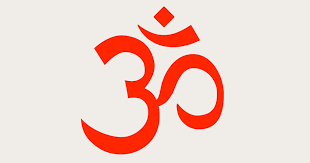
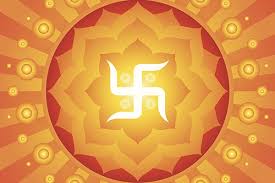
The Om signifies the Brahman the universal consciousness or the cosmic energy. Swastika is a symbol of well-being, and happiness, spread in all four quarters. It is not the Hakenkreuz or hooked cross used by the Nazis (Sathye, 2021) (12). The murti (statues) or images of Hindu deities will necessarily have these symbols embedded in the background. Swastika is also used by Buddhists and Jains. These symbols establish a direct connection between the Puranic (story version) and the scriptural (Vedic) version. It also reminds us that the edifice of the Puranas is built on the Vedic knowledge system.
While the OM represents the vital cosmic energy (stored or potential energy), the images of various deities represent particular aspects of that energy such as intellectual power or energy or mind power or energy. One can call this kinetic energy.
Accordingly, critical thinking, reasoning, and rationality are the very foundation of Hindu tradition. The deity that symbolizes these aspects is the Ganesh (elephant-headed God). Incidentally, Ganesh is the deity that is to be invoked before any other deity can be worshipped in the Hindu tradition. Another example is that of Hanuman (the monkey god). Hanuman is a representation of the mind. The human mind is like a monkey that keeps hopping from one branch of a tree to another. It is never still or stable. At the same time is an extremely powerful machine (Flaxington, 2020) (13), (Bach, 2018) (14). Hanuman is represented as a very powerful monkey that needs to be subjugated to reason represented by Rama who is also the epitome of ethical and moral character – a character from the epic Ramayana.
Consciousness and matter are represented by Ram and Sita or Krishna and Radha. Laxmana (Rama’s brother) is a representation of universal brotherhood. Typically, the images will be surrounded by nature or ecology signifying that the genesis thereof is also consciousness – the cosmic energy — Brahman.
Figure 3: Representation of reason (Ganesha) and mind (Hanuman)
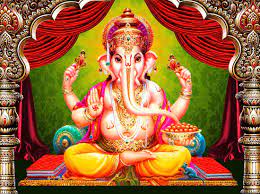
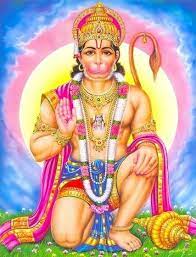
4.1 Hindu Ethics
Hindu practices are grounded in Hindu ethics. There are many dos and don’ts suggested by Hindu scriptures and illustrated through the Puranic stories. Ethics or Dharma is a fundamental pillar of Hindu Thought. Elaborate discussion of ethical and moral aspects of life can be found in Hindu scriptures.
Specific ethics have been prescribed at different life stages and to specific occupations called Varnashrama Dharma. However, some common values at all life stages and for all varnas as enunciated in the Patanjali Yoga Sutras (Yoga Institute, 2024) (15) are:
- Yama (moral discipline): (a) Ahimsa (non-violence) (b) Satya (truthfulness), (c) Asteya (non-stealing), (d) Brahmacharya (moderation), (e) aparigraha (non-greed or generosity)
- Niyama (practices/observances): (a) Saucha (cleanliness, purity); (b) Santosha (contentment/ non-greed); (c) Tapas (austerity); (d) Swadhyaya (self-study); (e) Samadhi (living in harmony with self and nature); (f) Dhyana and Dharana (concentration); (g) Pratyahara (Know Thy Self/turn inwards); and (h) Pranayama (mindfulness).
Importantly, Hindus are not hostile to LGBTQIA (Wilhelm, 2004) or voluntary euthanasia. When everything is just divine as per Hindu tradition there is no question of animosity towards LGBTQIA (16). Hindu tradition has venerated enlightened people who chose to embrace death voluntarily (Sinha et al., 2012) (17).
The tradition also specifies the goals of human life. These are Dharma, (do your duty), Artha (industriousness), Kama (raising a family), and Moksha (self-realization). If one has to summarise the meaning and purpose of life as per the Hindu tradition it would be self-realization. Hindu scriptures assert that by knowing yourself you can know what the whole game of the providence is all about! ‘When one is known, he becomes the knower of all’ (Sastri, 2018, paragraph 1) (18).
5. Conclusion
In this essay, I have elaborated on the one-hour talk that I gave at Xavier College. At the end of the talk, Hindu Temple Acharya Prakash Pande was invited to chant the meditation mantra. He chanted the Rigvedic mantra:
आ नो भद्राः क्रतवो यन्तु विश्वत्व् अदब्धासो अपरीतास उद्भिदः |
देवा नो यथा सदमिद्वृधे असन्न-प्रायुवो रक्षितारो दिवे-दिवे || 1.89.1 ||
I translated the Rigvedic mantra for the students: “May auspicious works, unmolested, unimpeded, and subversive (of foes), come to us from every quarter; may the gods, turning not away from us, but granting us protection day by day, be ever with us for our advancement” (Wilson, 1866) (19).
Pandit ji also recited the Brihad-Aranyaka Upanishad (V.2.1) mantra:
ॐ।पूर्णमदःपूर्णमिदंपूर्णात्पूर्णमुदच्यते।पूर्णस्य पूर्णमादाय पूर्णमेवावशिष्यते ॥
“Om. That is Full, this is full, from that Full, this full emanates. Taking away this full from that Full, the Full still remains behind. Om. Peace, Peace, Peace” (Wisdom Library, 2020) (20).
References:
- The Hindu Marriage Act, 1955. https://highcourtchd.gov.in/hclscc/subpages/pdf_files/4.pdf
- Sathye, M (2020) Hindu, Hinduism, Hindutva. https://
milindsathye.medium.com/hindu- hinduism-and-hindutva- 5f9dcadbe6da - Cooper, D. (2003) World Philosophies: An historical introduction, Blackwell Publishing, USA.
- Oxford Reference (n.d.) https://www.
oxfordreference.com/display/ 10.1093/oi/authority. 20110803095456806 - Price, et al. Research Methods in Psychology. 3rd American Edition. https://opentext.wsu.edu/carriecuttler/chapter/methods-of-knowing/
- Yates (2017). Five ways Ancient India changed the World – with Maths. https://theconversation.com/five-ways-ancient-india-changed-the-world-with-maths-84332
- Chandogya Upanishad, by Swami Lokeswarananda. https://www.wisdomlib.org/hinduism/book/chandogya-upanishad-english/d/doc239005.html#:~:text=Everything%20comes%20from%20Brahman%2C%20everything,when%20he%20leaves%20this%20world.
- Ghosh, S. (2014). Rigveda for the Layman. Munshiram Manoharlal. New Delhi.
- Radhakrishnan, S. (1992). The Principal Upanishads. Humanity Books. New York.
- Universal Medicine. https://www.universalmedicine.com.au/articles/emc2-everything-energy-why-do-we-continue-ignore-energetic-truth
- Exoplanet Exploration. “What is an Exoplanet?” https://exoplanets.nasa.gov/what-is-an-exoplanet/what-is-the-universe/
- Sathye, M. (April 12, 2021). Should the Swastika be Banned? https://kreately.in/should-the-swastika-be-banned/
- Flaxington, B. D. (August 6, 2020). Your most powerful underutilized tool: Your mind. Psychology Today. https://www.psychologytoday.com/us/blog/understand-other-people/202008/your-most-powerful-underutilized-tool-your-mind
- Bach, B. (June 18, 2018). Body-Mind. Stanford Medicine. https://scopeblog.stanford.edu/2018/06/18/mind-this-research-reveals-the-power-of-the-mind/
- The Yoga Sutras of Patanjali: The Yamas and Niyamas. The Yoga Institute. https://yogainstitute.com.au/the-yoga-sutras-of-patanjali-the-yamas-and-niyamas/
- Wilhelm, A. D. (2004). Tritiya-Prakriti: People of the Third Sex – Understanding Homosexuality, Transgender Identity and Intersex Conditions through Hinduism. https://www.amazon.com.au/Tritiya-Prakriti-Understanding-Homosexuality-Transgender-Conditions/dp/1413435343
- Sinha, V.K., Basu, S., & Sarkhel, S. (2012). Euthanasia: An Indian Perspective. Indian Journal of Psychiatry. https://www.ncbi.nlm.nih.gov/pmc/articles/PMC3440914/
- Mundaka Upanishad with Shankara’s Commentary, by S. Sitarama Sastri (1905). https://www.wisdomlib.org/hinduism/book/mundaka-upanishad-shankara-bhashya/d/doc145076.html
- Rig Veda, translation and commentary by H. H. Wilson, 1866. https://www.wisdomlib.org/hinduism/book/rig-veda-english-translation/d/doc829922.html
- Isopanisad, by Srisa Chandra Vasu (1909). https://www.wisdomlib.org/hinduism/book/isopanisad-madhva-commentary/d/doc486041.html

